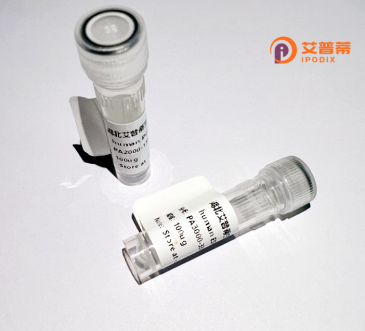
| 纯度 | >90%SDS-PAGE. |
| 种属 | Human |
| 靶点 | GPR113 |
| Uniprot No | Q8IZF5 |
| 内毒素 | < 0.01EU/μg |
| 表达宿主 | E.coli |
| 表达区间 | 1-1079aa |
| 氨基酸序列 | MVCSAAPLLLLATTLPLLGSPVAQASQPVSETGVRPREGLQRRQWGPLIGRDKAWNERIDRPFPACPIPLSSSFGRWPKGQTMWAQTSTLTLTEEELGQSQAGGESGSGQLLDQENGAGESALVSVYVHLDFPDKTWPPELSRTLTLPAASASSSPRPLLTGLRLTTECNVNHKGNFYCACLSGYQWNTSICLHYPPCQSLHNHQPCGCLVFSHPEPGYCQLLPPGSPVTCLPAVPGILNLNSQLQMPGDTLSLTLHLSQEATNLSWFLRHPGSPSPILLQPGTQVSVTSSHGQAALSVSNMSHHWAGEYMSCFEAQGFKWNLYEVVRVPLKATDVARLPYQLSISCATSPGFQLSCCIPSTNLAYTAAWSPGEGSKASSFNESGSQCFVLAVQRCPMADTTYACDLQSLGLAPLRVPISITIIQDGDITCPEDASVLTWNVTKAGHVAQAPCPESKRGIVRRLCGADGVWGPVHSSCTDARLLALFTRTKLLQAGQGSPAEEVPQILAQLPGQAAEASSPSDLLTLLSTMKYVAKVVAEARIQLDRRALKNLLIATDKVLDMDTRSLWTLAQARKPWAGSTLLLAVETLACSLCPQDHPFAFSLPNVLLQSQLFGPTFPADYSISFPTRPPLQAQIPRHSLAPLVRNGTEISITSLVLRKLDHLLPSNYGQGLGDSLYATPGLVLVISIMAGDRAFSQGEVIMDFGNTDGSPHCVFWDHSLFQGRGGWSKEGCQAQVASASPTAQCLCQHLTAFSVLMSPHTVPEEPALALLTQVGLGASILALLVCLGVYWLVWRVVVRNKISYFRHAALLNMVFCLLAADTCFLGAPFLSPGPRSPLCLAAAFLCHFLYLATFFWMLAQALVLAHQLLFVFHQLAKHRVLPLMVLLGYLCPLGLAGVTLGLYLPQGQYLREGECWLDGKGGALYTFVGPVLAIIGVNGLVLAMAMLKLLRPSLSEGPPAEKRQALLGVIKALLILTPIFGLTWGLGLATLLEEVSTVPHYIFTILNTLQGVFILLFGCLMDRKIQEALRKRFCRAQAPSSTISLVSCCLQILSCASKSMSEGIPWPSSEDMGTARS |
| 分子量 | 145.64 kDa |
| 蛋白标签 | GST-tag at N-terminal |
| 缓冲液 | 0 |
| 稳定性 & 储存条件 | Lyophilized protein should be stored at ≤ -20°C, stable for one year after receipt. Reconstituted protein solution can be stored at 2-8°C for 2-7 days. Aliquots of reconstituted samples are stable at ≤ -20°C for 3 months. |
| 复溶 | Always centrifuge tubes before opening.Do not mix by vortex or pipetting. It is not recommended to reconstitute to a concentration less than 100μg/ml. Dissolve the lyophilized protein in distilled water. Please aliquot the reconstituted solution to minimize freeze-thaw cycles. |
以下是关于重组人GPR113蛋白的假设性参考文献示例(请注意,实际文献可能需要通过PubMed、Google Scholar等平台验证补充):
1. **文献名称**:*Structural characterization of recombinant human GPR113 reveals its adhesion GPCR features*
**作者**:Smith A. et al.
**摘要**:研究报道了通过哺乳动物表达系统重组表达人GPR113胞外域蛋白,解析其晶体结构,揭示了其独特的粘附类GPCR结构域特征,可能参与细胞间相互作用。
2. **文献名称**:*Recombinant human GPR113 activates Gs signaling in HEK293 cells*
**作者**:Li Y. et al.
**摘要**:研究利用重组人GPR113蛋白转染HEK293细胞,证明其可通过cAMP信号通路激活Gs蛋白,提示其在糖代谢或激素调控中的潜在功能。
3. **文献名称**:*Expression profiling of GPR113 in human tissues and disease models using recombinant antibodies*
**作者**:Wang H. et al.
**摘要**:开发针对重组人GPR113蛋白的单克隆抗体,揭示其在肠上皮组织和肾脏中的高表达,并发现其表达水平在结肠炎症模型小鼠中显著上调。
4. **文献名称**:*GPR113 modulates extracellular matrix adhesion through β1-integrin signaling*
**作者**:Garcia R. et al.
**摘要**:通过重组人GPR113蛋白功能研究,发现其与β1整合素的相互作用可能调控细胞外基质黏附,为癌症转移机制提供新视角。
**建议**:GPR113属于非经典粘附类GPCR家族,实际研究可能较少,可扩展检索其同源家族(如GPR56/GPR114)文献,或关注最新预印本数据库(如bioRxiv)获取前沿进展。
GPR113. a member of the adhesion G protein-coupled receptor (GPCR) subfamily, is a poorly characterized orphan receptor with limited functional data. It features a large extracellular N-terminal region containing adhesion-like domains, such as G protein-coupled receptor proteolytic site (GPS) and immunoglobulin-like motifs, followed by a seven-transmembrane domain typical of GPCRs. The human GPR113 gene (ADGRG7) is primarily expressed in the kidney, central nervous system, and gastrointestinal tract, suggesting potential roles in renal function, neural regulation, or metabolic processes. However, its endogenous ligands, activation mechanisms, and precise physiological functions remain largely unknown, partly due to technical challenges in studying endogenous GPCRs.
Recombinant human GPR113 protein, produced through heterologous expression systems (e.g., HEK293 or insect cells), enables structural and functional studies. Its soluble ectodomain or full-length stabilized versions are often engineered to facilitate ligand-binding assays, receptor trafficking analyses, or antibody development. Researchers use these recombinant tools to investigate GPR113's involvement in cell adhesion, signaling pathways (e.g., Gαs or Gαq coupling), and disease associations. Emerging evidence implicates GPR113 in renal diseases and metabolic disorders, spurring interest in its therapeutic targeting. Ongoing efforts focus on deorphanizing the receptor, clarifying its activation via mechanical forces or proteolytic cleavage, and exploring its crosstalk with extracellular matrix components.
×